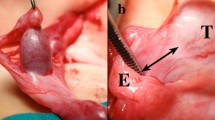Abstract
The processus vaginalis (PV) forms as a peritoneal diverticulum within the gubernaculum testis to allow the testis to exit from the abdominal cavity. Failure of its closure leads to inguinal hernias and hydroceles. Ascending testis, which is likely to be an acquired form of undescended testis, may also be part of the spectrum of failure of regression of the PV At orchidopexy for cryptorchidism in older boys with a history of a scrotal testis in infancy, we find that the PV persists as a fibrous string, preventing normal elongation of the vas deferens and gonadal vessels with increasing size of the boy. We propose that the ascending testis is actually ‘stationary’, and is caused by persistence of a fibrous remnant of the PV Seen in this light, ascending testes are directly related to inguinal hernias.
Similar content being viewed by others
References
Abe T, Hutson JM (1994) Calcitonin gene-related peptide injected ectopically alters gubernacular migration in the flutamide-treated rat with cryptorchidism. Pediatr Surg Int 9: 551–554
Atwell JD (1985) Ascent of the testis: facto or fiction. Br J Urol 57: 474–477
Backhouse KM (1964) The gubernaculum testis Hunteri: testicular descent and maldescent. Ann Roy Coll Surg Engl 35: 15–33
Backhouse KM, Butler H (1960) The gubernaculum testis of the pig. J Anat 94: 107–121
Bergin WC, Gier HT, Marrion GB, Coffman JR (1970) A developmental concept of equine cryptorchidism. Biol Rprod 3: 82–89
Bianchi A, Squire BR (1989) Transscrotal orchidopexy: orchidopexy revised. Pediatr Surg Int 4: 189–192
Donnell SC, Rickwood AMK, Jee LD, Jackson M (1995) Congenital testicular maldescent: significance of the complete hernial sac. Br J Urol 75: 702–703
Fenton EJM, Woodward AA, Hudson IL, Marschner I (1990) The ascending testis. Pediatr Surg Int 5: 6–9
Goh DW, Hutson JM (1992) Is the retractile testis a normal, physiological variant or an anomaly that requires acive treatment? Pediatr Surg Int 7: 249–252
Hutson JM, Beasley SW (1992) Descent of the testis (Edward Arnold), pp 55–59
John Radcliffe Hospital Cryptorchidism Study Group (1986) Cryptorchidism: an apparent substantial increase since 1960. Br Med 1293: 1401–1404
Myers NA, Officer CB (1975) Undescended testes: congenital or acquired? Aust Paediatr J 11: 76–80
Rowe MI, Copelson LW, Clatworthy HW (1969) The patent processus vaginalis and the inguinal hernia. J Pediatr Surg 4: 102–106
Scorer CG (1962) The anatomy of testicular descent-normal and incomplete. Br J Surg 49: 357–367
Scorer CG, Farrington GH (1971) Congenital deformities of the testis and epididymis. Butterworth and Co. Ltd., London, p 85
Smith JA, Hutson JM, Beasley SW, Reddihough DS (1989) The relationship between cerebral palsy and cryptorchidism. J Pediatr Surg 24: 1303–1305
Steinberger A (1991) Effects of temperature on the biochemistry of the testis. Adv Exp Med Biol 286: 33–47
Wells LJ (1943) Descent of the testis: anatomical and hormonal considerations. Surg 14: 436–472
Wylie GG (1985) The retractile testis. Med J Aust 140: 403–405
Author information
Authors and Affiliations
Rights and permissions
About this article
Cite this article
Clarnette, T.D., Hutson, J.M. Is the ascending testis actually ‘stationary’? Normal elongation of the spermatic cord is prevented by a fibrous remnant of the processus vaginalis. Pediatr Surg Int 12, 155–157 (1997). https://doi.org/10.1007/BF01349987
Accepted:
Issue Date:
DOI: https://doi.org/10.1007/BF01349987




